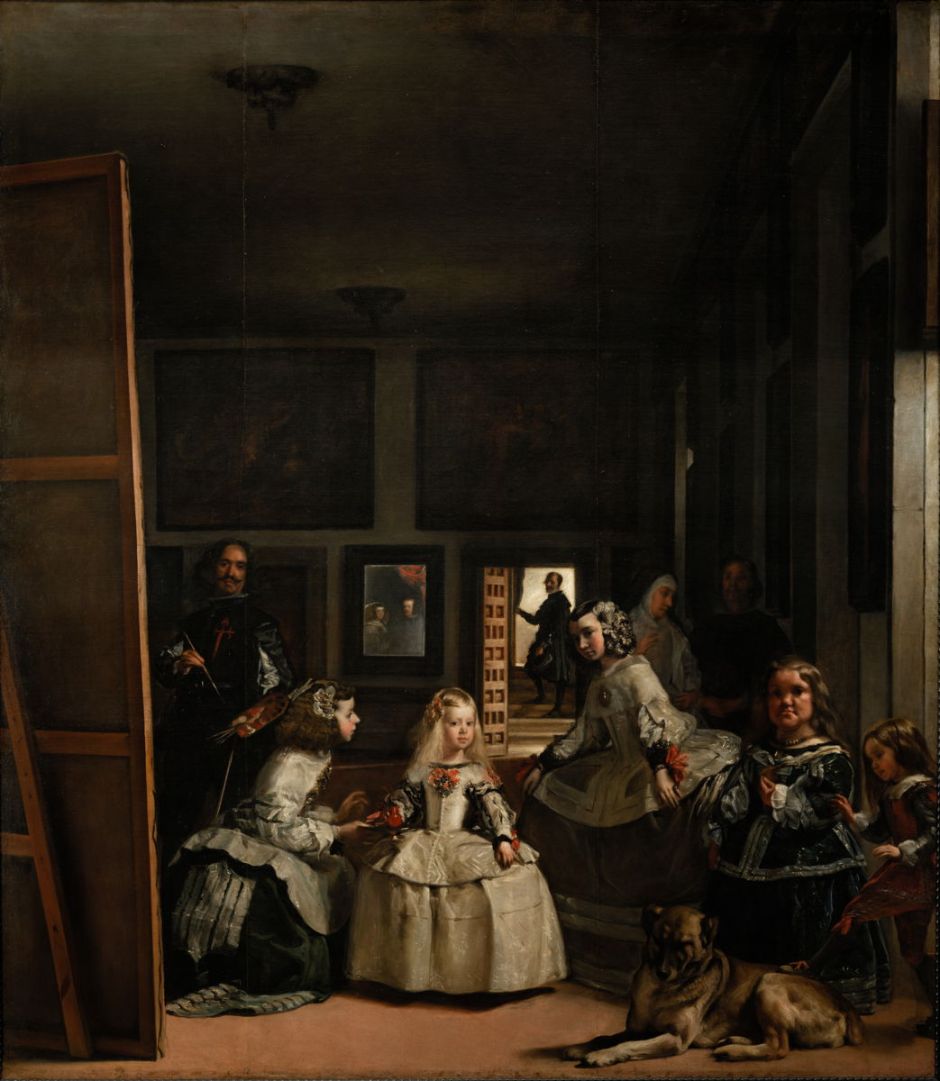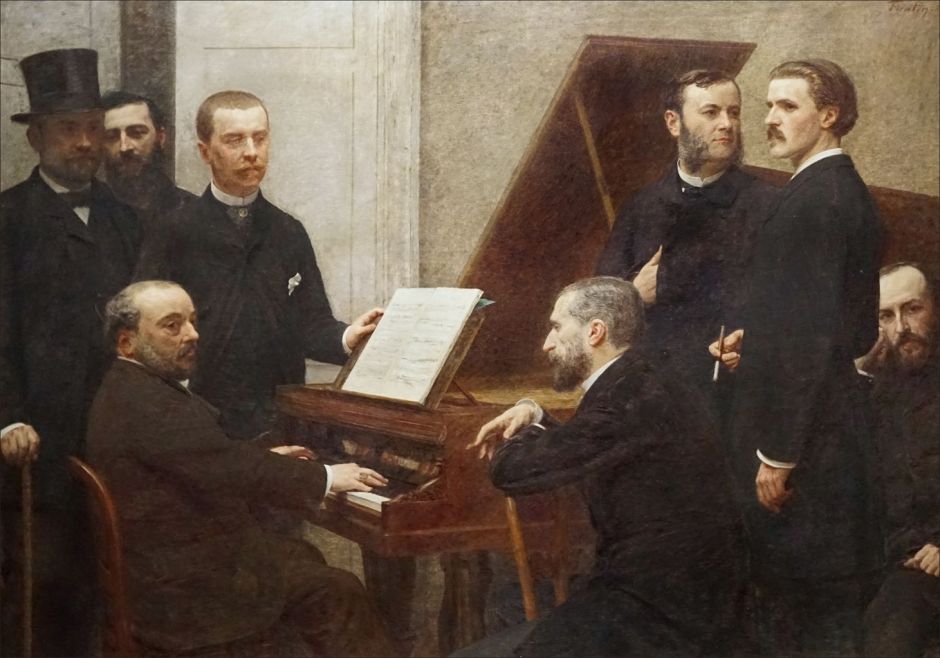Reading visual art: 164 Group portraits A
This week’s two articles about reading paintings consider some of the more famous and unusual depictions of the likenesses of three or more people. Individual portraits have long been popular, and for many artists have brought in the income they’ve needed to paint as a career. Painting three or more portraits in a single image presents greater challenges, and in many cases complicates their reading considerably. Among the paintings included in today’s article are some of the hardest of all to read, that remain controversial.
The first and key step in starting to read a group portrait is to discover who, where and when. For some, a little digging around in contemporary historical records may be sufficient.

When Lavinia Fontana was in Rome, she painted the remarkable family Portrait of Bianca degli Utili Maselli with six of her children (1604-5), showing this nobleman’s wife, five of her sons, and her daughter Verginia, whose image is labelled to distinguish her from her brothers. The mother died in September 1605 after giving birth to her nineteenth child. Their lapdog was a sign of fidelity, and Fontana’s depiction of clothing exquisite.

In 1617, Michiel van Mierevelt and his son Pieter, specialists in portraiture, painted The Anatomy Lesson of Dr. Willem van der Meer, one of the earliest portraits of a social group from the Dutch Golden Age. The members of this group are all ignoring the cadaver in front of them, preferring to look at the painter, and are thought to be members of the Surgeons’ Guild of the city of Delft, who commissioned this work.

Rembrandt painted his Anatomy Lesson of Dr. Nicolaes Tulp in 1632, as an early commission soon after his arrival in Amsterdam. It’s a group portrait of distinguished members of the Surgeons’ Guild in their working environment. Most remarkable is the fact that its principal, Dr Tulp, and most of his colleagues aren’t looking at the dissected forearm.

A decade later, Rembrandt’s vast group portrait of The Night Watch (1642) is perhaps the most famous of them all, although it’s more correctly titled Militia Company of District II under the Command of Captain Frans Banninck Cocq. It features the commander and seventeen members of his civic guard company in Amsterdam, and took the artist three years to complete from his first commission to paint this for display in the great hall of the guards.
Captain Frans Banninck Cocq (in black with a red sash), followed by his lieutenant Willem van Ruytenburch (in yellow with a white sash) are leading out this militia company, their colours borne by the ensign Jan Visscher Cornelissen. The small girl to the left of them is carrying a dead chicken, a symbol of arquebusiers, the type of weapon several are carrying.

Portraits of royal families have been regular commissions for their court painters. The best of these have greater artistic merit. Diego Velázquez’ Las Meninas, translated as The Maids of Honour, from about 1656-57 is another well-known example of a group portrait. In what is overtly a depiction of eleven people and a dog in a room in the Alcázar Palace, he uses composition and gaze to tell us more. Much depends on what we believe most of the figures are looking at. Reflected in the rectangular plane mirror on the far wall are King Philip IV and his wife Queen Mariana of Austria.
There has been dispute over whether the reflection shows the royal couple stood where the viewer is, or the mirror is reflecting their painted images on Velázquez’s canvas. How their images were generated is probably of secondary importance, as either way the gaze of most of the other figures is clearly directed not at the viewer, but at the King and Queen, who may be getting up to leave after sitting for Velázquez to paint them. In this reading, the most important people not in the painting only appear in reflection and the gaze of others.

In April 1800, Francisco Goya was commissioned by King Carlos IV to paint a family portrait, which proved to be the last of his royal commissions before the war with France, and his most important. It’s often said that Goya’s inspiration for his large canvas of Carlos IV of Spain and His Family (1800-01) was Las Meninas, but what he has painted is different in almost every respect other than the fact that the artist has taken the opportunity to include a self-portrait of himself painting the painting, as it were. Goya captures a moment of optimism when Spain and France were allies, and portrays his royal figures in stark reality.
In the mid-nineteenth century Gustave Courbet’s Painter’s Studio proved a turning point. One of the most unconventional group portraits, it influenced successors including Henri Fantin-Latour.

The Painter’s Studio from 1855 is one of the great ‘problem paintings’ that has been extensively analysed and ‘explained’ as allegory. Those classical approaches have recently been challenged by Herbert, who argues that trying to determine whether it is allegorical or realist is asking the wrong question.
The figures in the painting show individuals who had influence over Courbet’s life and artistic career. At the right are the artist’s friends and admirers, including his first patron Alfred Bruyas, critics Champfleury and Baudelaire who had been so positive in their reactions to his work, and others. At the left, a man with dogs has been interpreted as an allegory of the Emperor Napoleon III. Behind him are figures who were long assumed to be allegorical, but Hélène Toussaint has identified them as contemporary people, most of whom had been supporters of the Emperor’s regime.

Following a long series of studies, Henri Fantin-Latour’s first group portrait Homage to Delacroix was completed almost ten years later, in 1864. Its figures include two, Champfleury and Baudelaire, who had appeared in Courbet’s Painter’s Studio, together with those who Fantin rated as the brightest and best among modern painters, including his friends Whistler and Manet. Inevitably he included himself among such distinguished company.
But Fantin neither poses the puzzle of Courbet’s allegory, nor the social gathering of Manet’s Music in the Tuileries. Instead we have seven men looking at the viewer, and three gazing somewhere else. It almost looks like a ‘real’ group portrait, but lacking interactions between the figures, it’s clear that it’s eleven individual portraits, including that of Delacroix.

Fantin pressed on with his unusual group portraits, here in Studio at Les Batignolles from 1870, showing his friend Manet painting with a small group of friends peering over his shoulders. Its debt to Courbet is palpable. The figures were identified by the artist as:
- Otto Schölderer (standing, left),
- Pierre-Auguste Renoir,
- Émile Zola,
- Edmond Maître,
- Frédéric Bazille,
- Claude Monet (standing, right),
- Édouard Manet (seated, left)
- Zacharie Astruc (seated, right).
As a window into history, this is unique, showing Manet, Renoir, Zola, Bazille (who was to die that November in the Franco-Prussian War) and Monet in a fictional snapshot; it also inspired Bazille to paint a response and seems to have struck a chord with both artistic circles and the critics of the day. Although Fantin has integrated his figures better than in earlier paintings, this begs many questions such as what they’re all doing together, and whether the painting is about homage to Manet, who was still very much alive, or the meeting of an imaginary gentlemen’s club.

The sixth and last of Fantin’s group portraits, Around the Piano from 1885, shows members of a Wagner fan club in Paris at the time. They are each gazing at something different and not interacting in the least. Emmanuel Chabrier is playing the piano without looking at its keyboard or the music, and its other figures (bar one) appear distracted.

Maurice Denis was one of the few artists to take a deep interest in the late paintings of Paul Cézanne, and in 1900 paid his respects (although Cézanne didn’t die until 1906) in this Homage to Cézanne. The artist to whom this group of Nabis are paying their respects is represented by a painting, Cézanne’s Fruit Bowl, Glass and Apples. Although not entirely cohesive as a group, there are clear interactions taking place, and gazes reflect that, with Odilon Redon at the left and Paul Sérusier (foreground, at the right edge of the painting) clearly engaged with one another.

In 1902-03, Félix Vallotton painted a smaller group of Nabis in his Five Painters. Only Édouard Vuillard and Ker-Xavier Roussel seem to be joined in discussion, and there’s a strange array of hands around the centre of the canvas.
Tomorrow I’ll look at more conventional group portraits, including some featuring the families of artists.